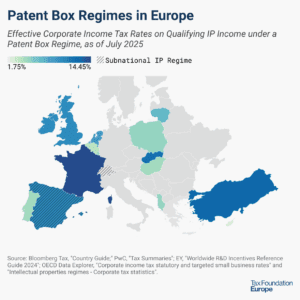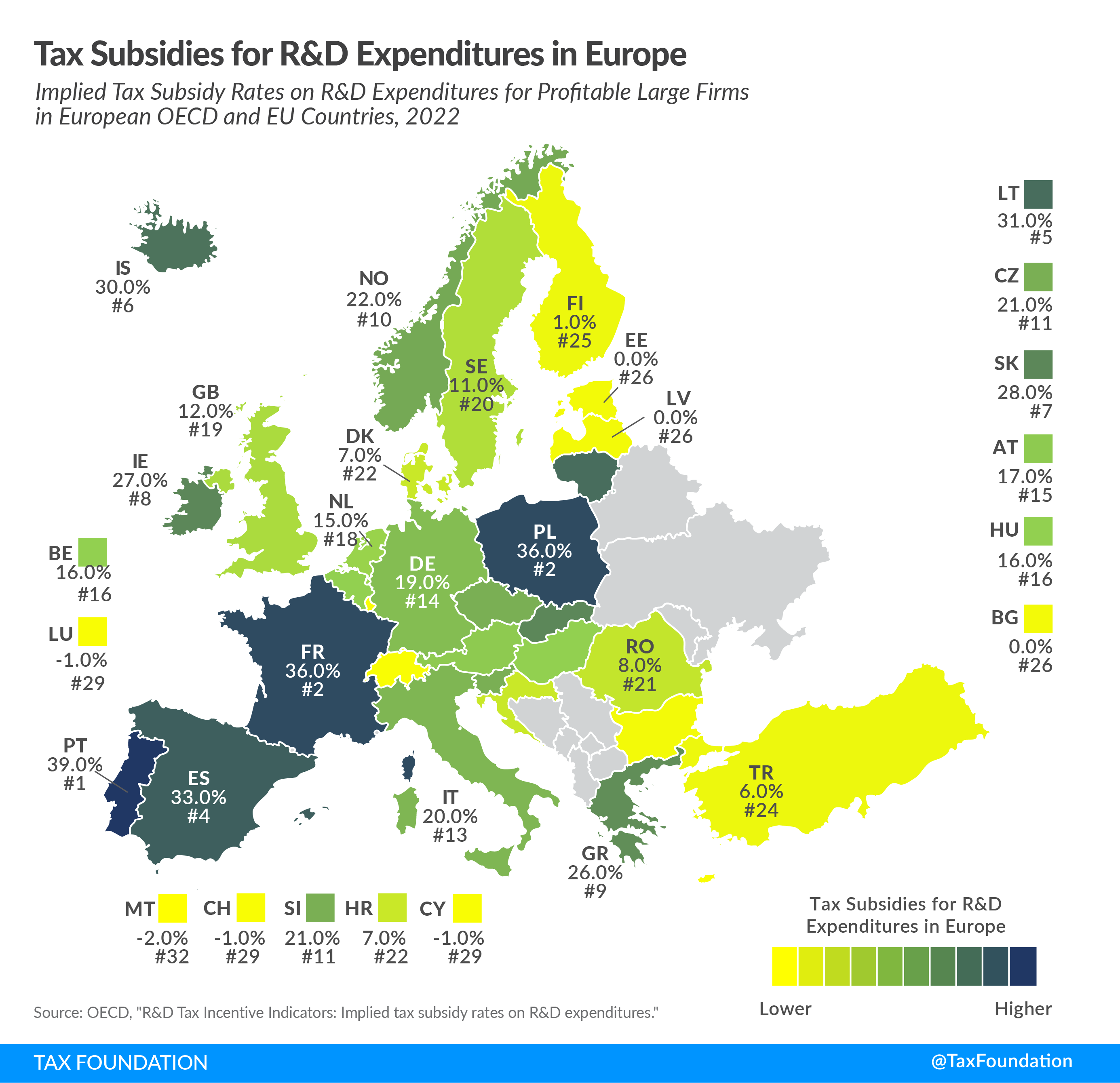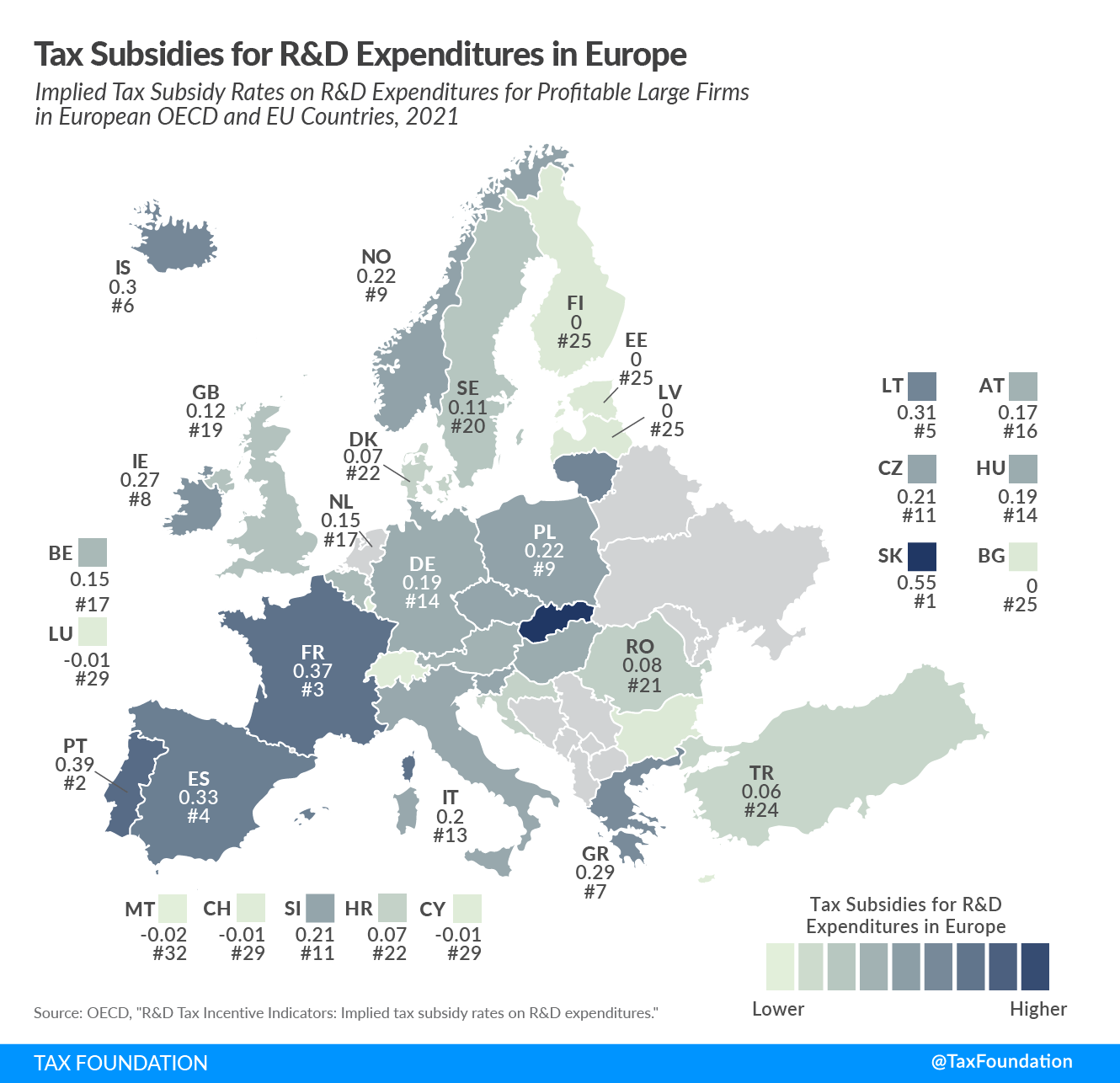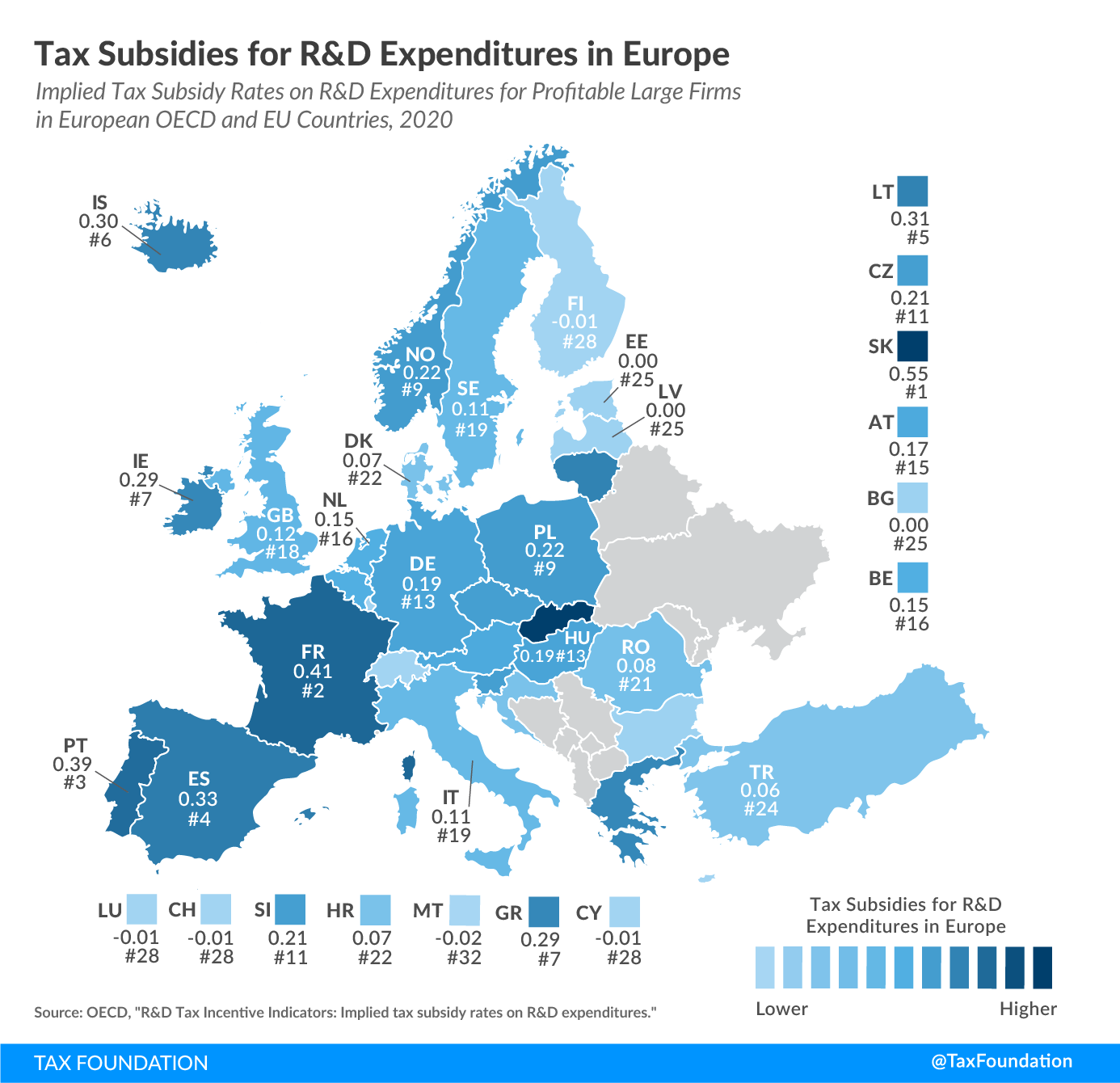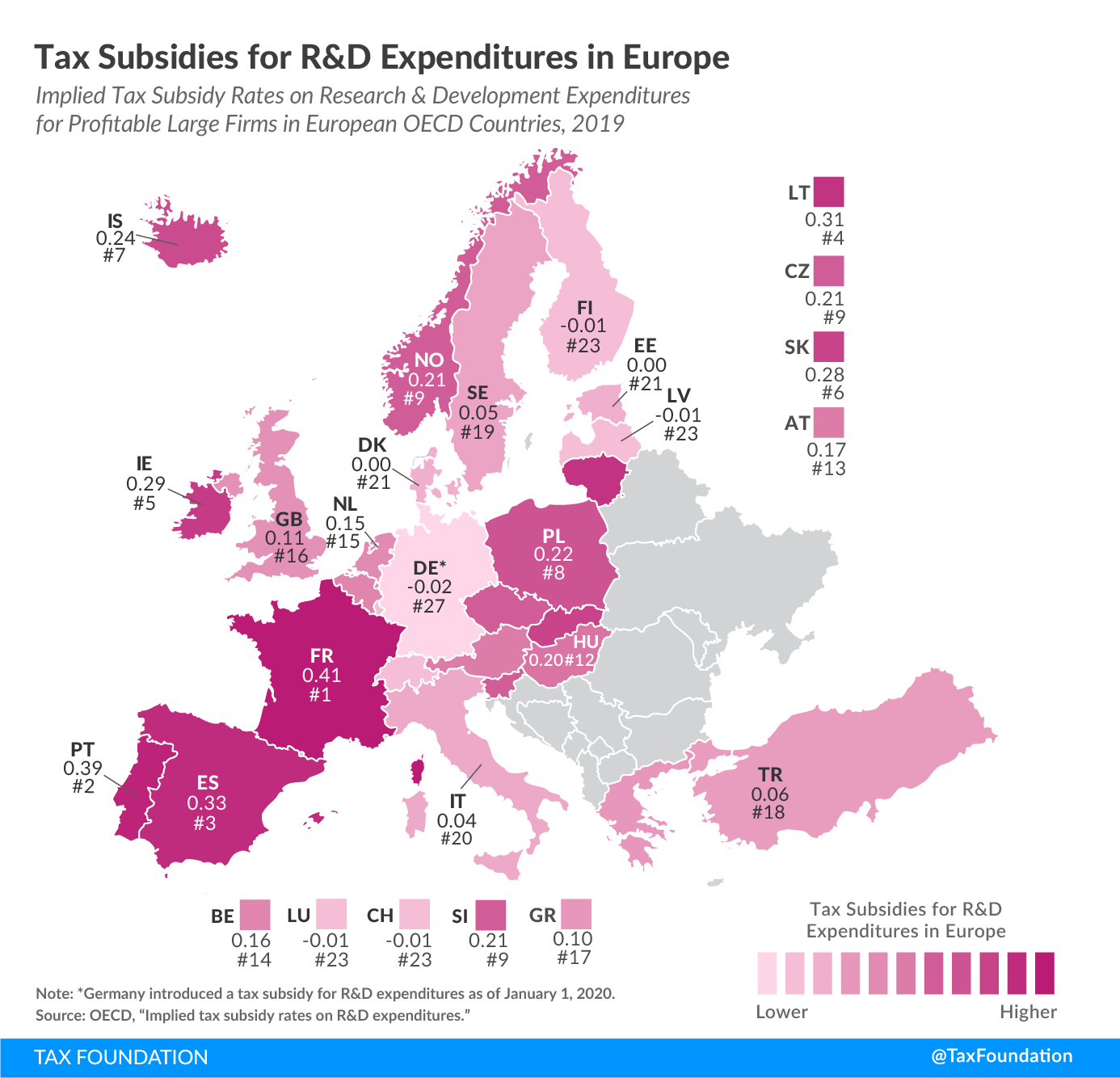
Many countries incentivize business investment in research and development (R&D), intending to foster innovation. A common approach is to provide direct government funding for R&D activity. However, a significant number of jurisdictions also offers R&D tax incentives.
These generally take two forms, namely patent boxes—taxing income derived from intellectual property at a rate below the statutory corporate income taxA corporate income tax (CIT) is levied by federal and state governments on business profits. Many companies are not subject to the CIT because they are taxed as pass-through businesses, with income reportable under the individual income tax. rate—and taxA tax is a mandatory payment or charge collected by local, state, and national governments from individuals or businesses to cover the costs of general government services, goods, and activities. incentives for R&D expenditures. This map focuses on the latter, showing to what degree European countries grant expenditure-based R&D tax relief. The implied tax subsidy rate, developed by the OECD, is one way to measure the extent of expenditure-based R&D tax relief across countries. This implied tax subsidy rate measures the extent of the preferential treatment of R&D in a given tax system. The more generous the tax provisions for R&D, the higher the implied subsidy rates for R&D. An implied subsidy rate of zero means R&D does not receive preferential tax treatment.
Implied Tax Subsidy Rates on R&D Expenditures in European OECD and EU Countries, 2024
| SME | Large Firm | |||
|---|---|---|---|---|
| Profitable | Loss-making | Profitable | Loss-making | |
| Austria (AT) | 0.17 | 0.17 | 0.17 | 0.17 |
| Belgium (BE) | 0.16 | 0.15 | 0.16 | 0.15 |
| Bulgaria (BG) | 0 | 0 | 0 | 0 |
| Croatia (HR) | 0.04 | 0.03 | 0.07 | 0.05 |
| Cyprus (CY) | 0.02 | 0.02 | 0.02 | 0.02 |
| Czech Republic (CZ) | 0.24 | 0.17 | 0.24 | 0.17 |
| Denmark (DK) | 0.01 | 0.01 | 0.01 | 0.01 |
| Estonia (EE) | 0.04 | 0.04 | 0.04 | 0.04 |
| Finland (FI) | 0.12 | 0.09 | 0.12 | 0.09 |
| France (FR) | 0.36 | 0.36 | 0.36 | 0.29 |
| Georgia (GE) | 0 | 0 | 0 | 0 |
| Germany (DE) | 0.32 | 0.3 | 0.22 | 0.21 |
| Greece (GR) | 0.26 | 0.2 | 0.26 | 0.2 |
| Hungary (HU) | 0.17 | 0.16 | 0.17 | 0.16 |
| Iceland (IS) | 0.43 | 0.43 | 0.3 | 0.3 |
| Ireland (IE) | 0.27 | 0.27 | 0.27 | 0.27 |
| Italy (IT) | 0.09 | 0.09 | 0.09 | 0.09 |
| Latvia (LV) | 0 | 0 | 0 | 0 |
| Lithuania (LT) | 0.31 | 0.25 | 0.31 | 0.25 |
| Luxembourg (LU) | -0.01 | -0.01 | -0.01 | -0.01 |
| Malta (MT) | -0.02 | -0.02 | -0.02 | -0.02 |
| Netherlands (NL) | 0.31 | 0.3 | 0.15 | 0.14 |
| Norway (NO) | 0.22 | 0.22 | 0.22 | 0.22 |
| Poland (PL) | 0.36 | 0.28 | 0.36 | 0.28 |
| Portugal (PT) | 0.39 | 0.31 | 0.39 | 0.31 |
| Romania (RO) | 0.08 | 0.07 | 0.08 | 0.07 |
| Slovak Republic (SK) | 0.28 | 0.22 | 0.28 | 0.22 |
| Slovenia (SI) | 0.26 | 0.2 | 0.26 | 0.2 |
| Spain (ES) | 0.33 | 0.26 | 0.33 | 0.26 |
| Sweden (SE) | 0.11 | 0.11 | 0.11 | 0.11 |
| Switzerland (CH) | -0.01 | -0.01 | -0.01 | -0.01 |
| Turkey (TR) | 0.06 | 0.05 | 0.06 | 0.05 |
| United Kingdom (GB) | 0.22 | 0.17 | 0.18 | 0.18 |
| European Average | 0.17 | 0.15 | 0.16 | 0.14 |
| United States (US) - for comparison | 0.03 | 0.03 | 0.03 | 0.02 |
| People's Republic of China (CN) – for comparison | 0.32 | 0.25 | 0.32 | 0.24 |
Data compiled by Alex Mengden
The implied tax subsidy rates for large profitable firms vary significantly among countries that grant notable relief, ranging from 1 percent in Denmark to 39 percent in Portugal. France and Poland provide the second and third most generous relief after Portugal, with an implied tax subsidy rate of 36 percent.
Of the countries that grant notable relief, Denmark (1 percent), Cyprus (2 percent), and Estonia (4 percent) are the least generous. The implied tax subsidy rates of Bulgaria, Georgia, Latvia, Luxembourg, Malta, and Switzerland do not show any significant expenditure-based R&D tax relief.
Among the 33 major European countries with available data, the average implied subsidy rate for profitable large firms was 15.7 percent in 2024. In comparison, the United States only grants a subsidy rate of 3 percent to large profitable firms, while the People’s Republic of China grants a subsidy rate of 32 percent.
The OECD also provides implied tax subsidy rates for loss-making firms and for small and medium-sized enterprises (SMEs). Most countries covered in today’s map provide the same expenditure-based R&D tax relief to large firms and SMEs. Only France (in the case of loss-making firms), Germany, Iceland, the Netherlands, and the United Kingdom (in the case of profitable firms) are relatively more generous to SMEs than to large firms. Croatia and the United Kingdom (in the case of loss-making firms) offer slightly higher relief to large firms than to SMEs.
Some countries’ R&D tax incentives include refunds and carryover provisions, changing the implied tax subsidy rates for loss-making firms relative to profitable firms. This has resulted in lower average implied tax subsidy rates for loss-making firms relative to profitable firms, both for SMEs and large firms.
Stay informed on the tax policies impacting you.
Subscribe to get insights from our trusted experts delivered straight to your inbox.
Subscribe
